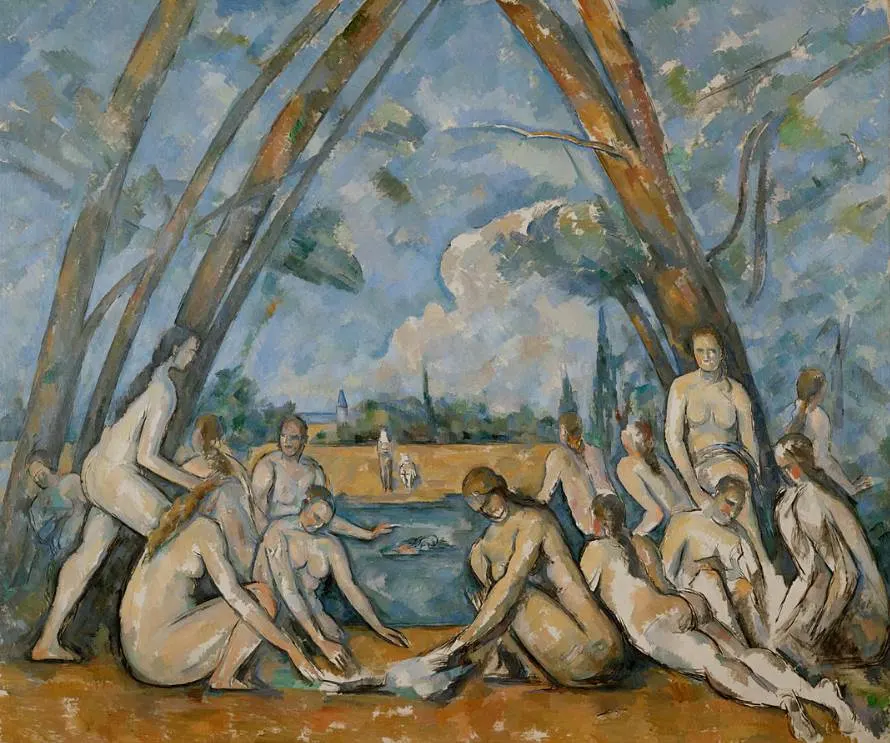The Impressionist artists of the late 19th century caused a revolution in the world of art. Instead of depicting things as they were like the Realist artists, they favored painting based on their impression of things.
Impressionist paintings often appear to be hazy and feature a sense of motion that makes the work come alive. Bal du Moulin de la Galette by Pierre-Auguste Renoir is a perfect example of this.
This influential art movement ended with the final exhibition of the Impressionists in 1886 and was replaced by Post-Impressionist artists who emerged in France.
They took it a step further and often integrated distorted forms and the remarkable use of light in their works.
In this article, you’ll discover some of the most famous Post-Impressionist paintings ever created so you can have a better idea of what this art movement was about.
1. The Starry Night – Vincent van Gogh
- Date created: 1889
- Dimensions: 73.7 × 92.1 centimeters (29.01 × 36.26 inches)
- Location: Museum of Modern Art (MoMA), New York City, United States
The Starry Night is arguably one of the most iconic paintings ever produced. Vincent van Gogh (1853-1890) painted the view from his bedroom window in the mental hospital in Saint-Rémy-de-Provence in June 1889.
This was just over a year before he took his own life, a notion that adds an extra dimension to this painting. Even though the stars are depicted accurately, It’s considered to be a representation of the fragile state of mind of the artist during this period.

2 The Card Players – Paul Cézanne
- Date created: 1894-1895
- Dimensions: 47.5 x 57 centimeters (18.7 x 22.4 inches)
- Location: Musée d’Orsay, Paris, France
The Card Players is the name of a series of paintings by Paul Cézanne with a similar subject. The five paintings all differ in color scheme and the larger works have more figures in them. It’s uncertain which version was produced first but Cézanne (1839-1906) made several preparatory studies for all of them.
The largest version of the paint that features just two people focusing on their cards was purchased by the Royal Family of Qatar for an incredible $250 million back in 2011. This was the highest price paid for a painting at the time, a record it held until 2017.

3. A Sunday Afternoon on the Island of La Grande Jatte – Georges Seurat
- Date created: 1884-1886
- Dimensions: 207.6 × 308 centimeters (81.7 × 121.25 inches)
- Location: Art Institute of Chicago, United States

A Sunday Afternoon on the Island of La Grande Jatte is one of the best examples of the Pontilist technique. This painting method was developed by Georges Seurat (1859-1891). A vast number of dots are applied to this large painting to produce a remarkable effect.
This Georges Seurat painting is the best-known work by the artist and depicts a Sunday afternoon on the banks of the Seine River. La Grande Jatte is a river island on the outskirts of the city, not too far away from the modern-day La Défense business district. It was a place where Parisians went to have a relaxing time, something perfectly captured in this remarkable work of art.
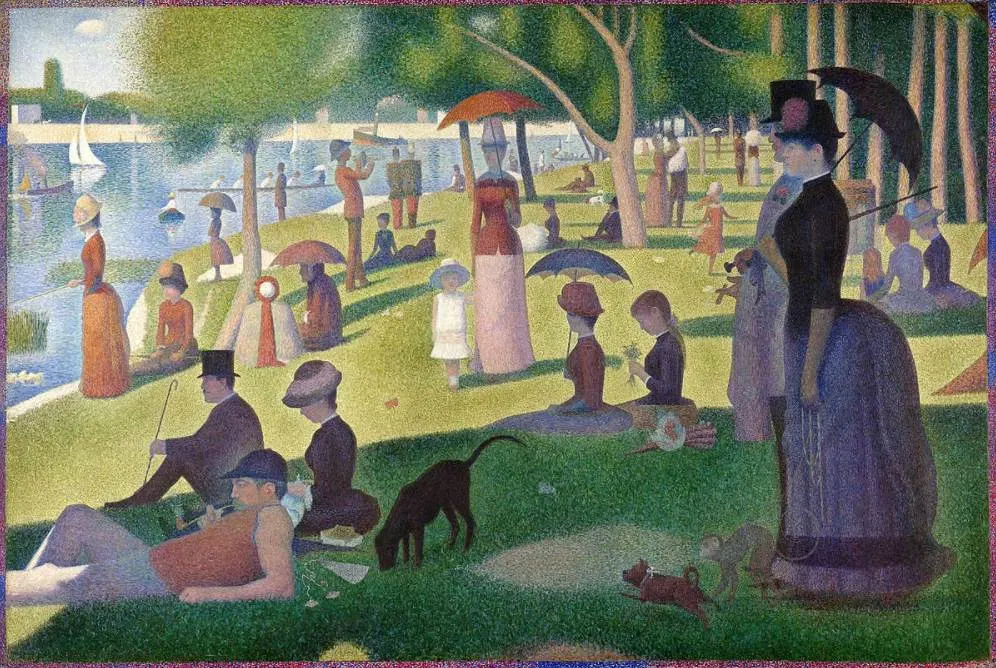
4. Where Do We Come From? What Are We? Where Are We Going? – Paul Gauguin
- Date created: 1897-1898
- Dimensions: 139 × 375 centimeters (55 × 148 inches)
- Location: Museum of Fine Arts, Boston, United States
Where Do We Come From? What Are We? Where Are We Going? is a monumental work of art painted by Paul Gauguin, one of the leading figures of the Post-Impressionist art movement. It was painted in the late 1890s, about 7 years after the artist had moved to the island of Tahiti.
The painting is considered to be a philosophical work. It has a self-explanatory title that Gauguin added to the top left corner of the work which reads “D’où venons-nous? Que sommes-nous? Où allons-nous? The work depicts multiple women in various stages of their lives.
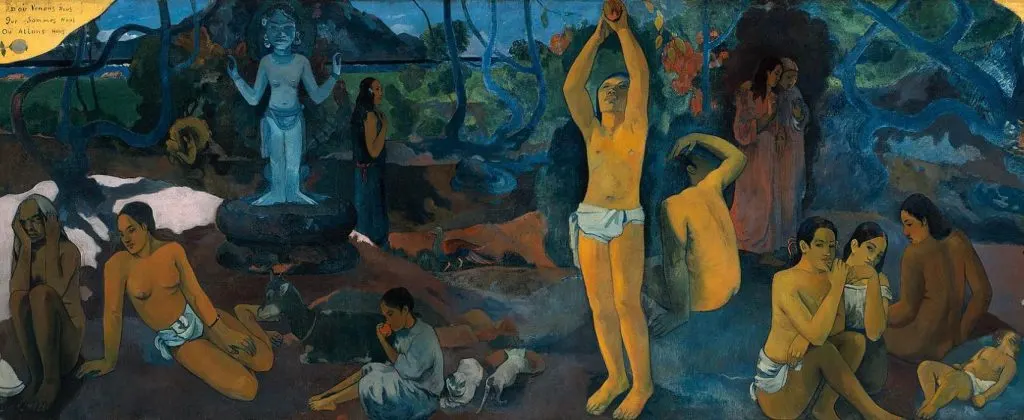
5. The Sleeping Gypsy – Henri Rousseau
- Date created: 1897
- Dimensions: 129.5 × 200.7 centimeters (51 × 79 inches)
- Location: MoMA, New York City, United States
The Sleeping Gypsy is an intriguing work of art produced by Henri Rousseau (1844-1910), a man who became a world-famous artist despite being nicknamed “Le Douanier.” This was a reference to the fact that he continued to have a regular job.
This fantastical scene depicts a gypsy woman who is so tired that she doesn’t even notice the nearby lion. The mandolin and drinking jar are her only possessions and the moonlight provides a remarkable atmosphere to this painting which the artist himself described as being “poetic.”
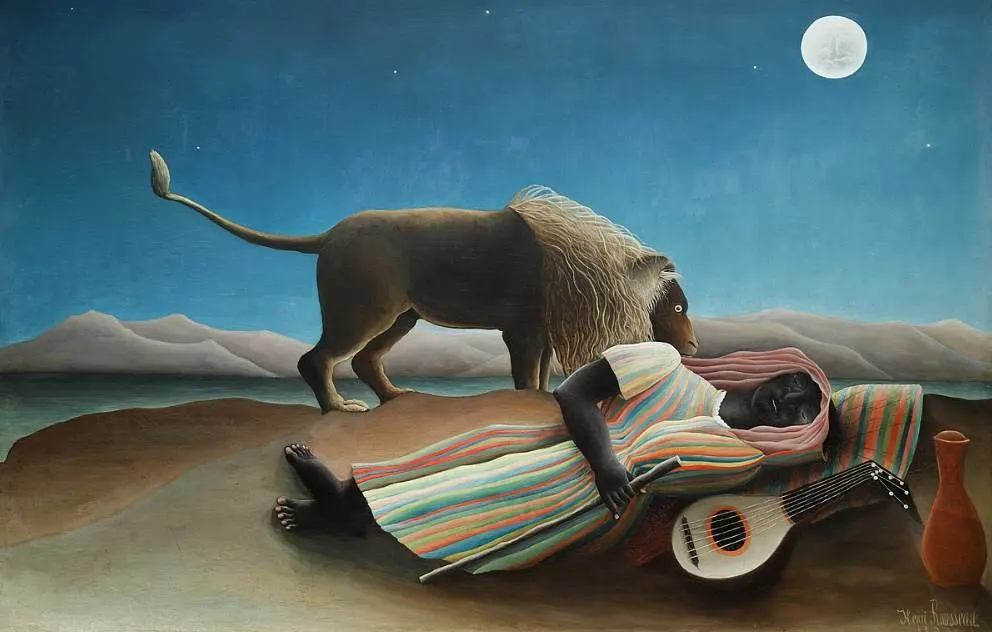
6. Café Terrace at Night – Vincent van Gogh
- Date created: 1888
- Dimensions: 80.7 × 65.3 centimeters (31.8 × 25.7 inches)
- Location: Kröller-Müller Museum, Otterlo, Netherlands
Café Terrace at Night is another famous painting by Vincent van Gogh which features the Starry Night we saw before. He used this element once mired in another famous painting called “Starry Night over the Rhône.” Both these paintings were produced while the artist lived in Arles in southern France.
This painting depicts a bar that still exists today on the Place du Forum in Arles. Today, this establishment is known as the “Café van Gogh” in honor of the man who once set up his easel nearby. The spot where he sat to paint this work is marked by a commemorative plaque as well, quite fascinating.
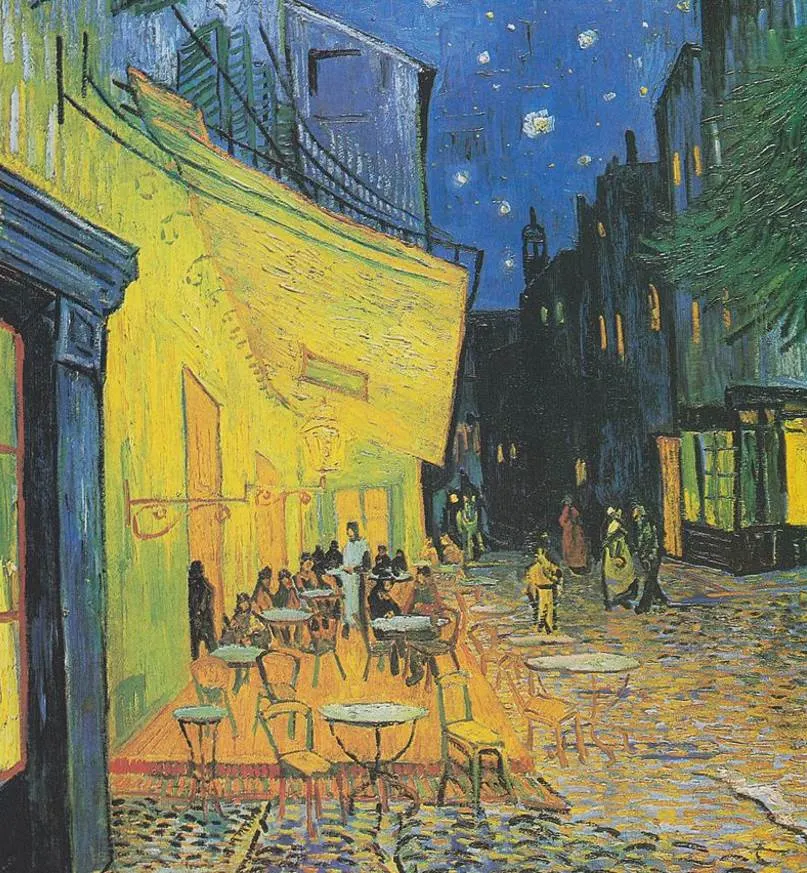
7. Bathers at Asnières – Georges Seurat
- Date created: 1884
- Dimensions: 201 × 301 centimeters (79 × 118 inches)
- Location: National Gallery, London, United Kingdom
Bathers at Asnières is another iconic painting by Georges Seurat, the founding father of Pointillism. This was the first monumental work that he painted depicting Parisians who are having a good time near the River Seine on the outskirts of the city. This is emphasized by the smoke of the factories in the distance.
Seurat had great hopes for this painting as he presented it to be displayed at the Paris Salon in 1885. His painting techniques were deemed too revolutionary to be accepted by conventional art critics. Unfortunately, it was only after the artist passed away from a mysterious disease at the age of 31 that his paintings started gaining the recognition they deserved.
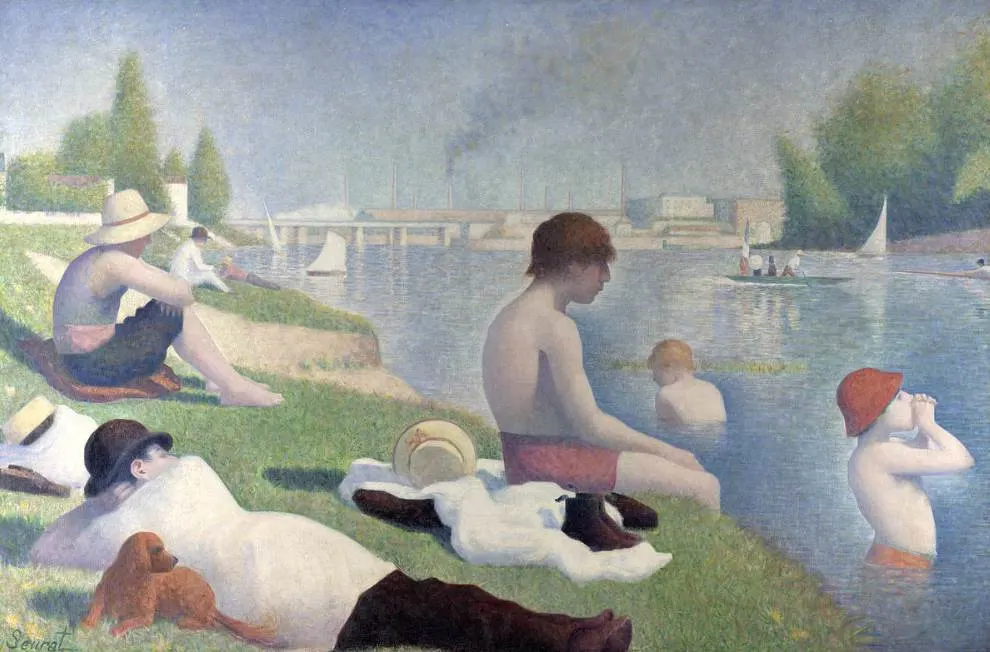
8. At the Moulin Rouge – Henri de Toulouse-Lautrec
- Date created: 1892-1895
- Dimensions: 123 × 140 centimeters (48 × 55 inches)
- Location: Art Institute of Chicago, United States
At the Moulin Rouge is one of the many paintings by Henri de Toulouse-Lautrec (1864-1901) that depicts an interior scene of this popular Parisian establishment in the late 19th century. The artist was a frequent visitor of the Moulin Rouge and also depicted himself in profile in the background.
Just like in the other versions, Henri de Toulous-Lautrec included people that have been identified. Two photographers and a writer are sitting at the table and the woman with the red hair was a can-can dancer at the Moulin Rouge named Jane Avril (1868-1943).

9. The Dream – Henri Rousseau
- Date created: 1910
- Dimensions: 204.5 × 298.5 centimeters (80.5 × 117.5 inches)
- Location: MoMA, New York City, United States
The Dream is a large painting by Henri Rousseau and one of the 25 of his works that featured a jungle scene. One of the most remarkable facts about The Dream is that it was the final painting that he ever produced. It was displayed at the Salon des Indépendants between March 18 and May 1, 1910, just a few months before he passed away in September of that year.
Rousseau was nostalgic about his past because he painted his Polish mistress named Yadwigha (Jadwiga) lying naked in this surreal landscape full of flowers, trees, and animals. We have to envision the scene with music because the dark figure is a snake charmer who is playing a reed instrument.
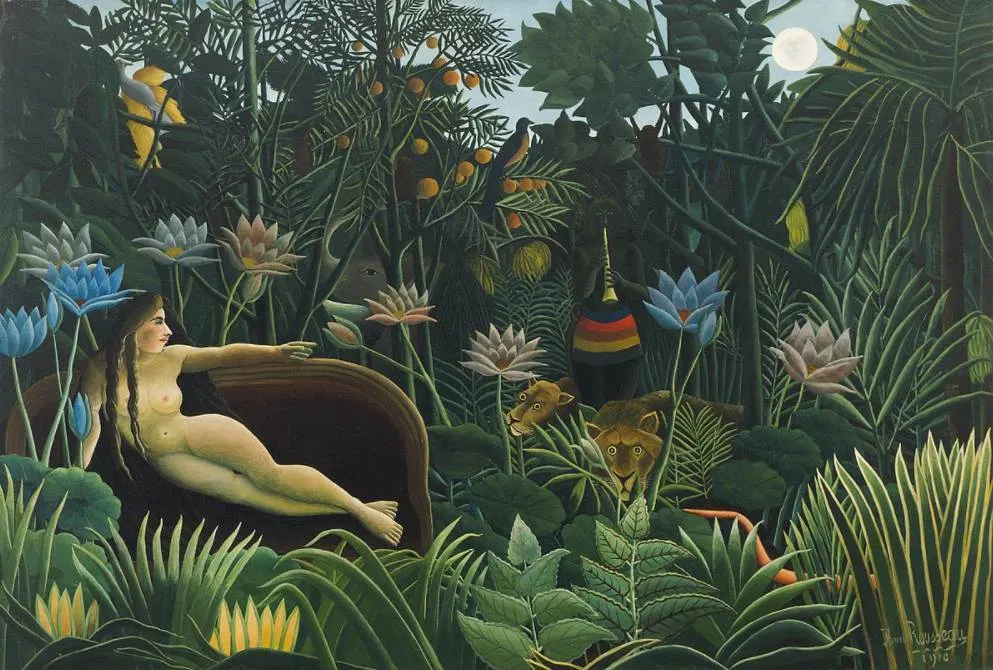
10. The Large Bathers – Paul Cézanne
- Date created: 1898–1905
- Dimensions: 210.5 × 250.8 centimeters (82.87 × 98.25 inches)
- Location: Philadelphia Museum of Art, United States
The Large Bathers is the name of several paintings of the same subject by Paul Cézanne. It’s considered to be one of the most influential paintings of modern art and one of the artist’s finest works. The largest of all versions is the one on display at the Philadelphia Museum of Art.
The painting was purchased by a trust fund operating for the museum in Philadelphia in 1937. The amount of $110,000 was paid for the painting, the equivalent of over $2.1 million today, not a meager sum during the Great Depression. This just emphasizes the influence the painting had just 3 decades after it was completed.
